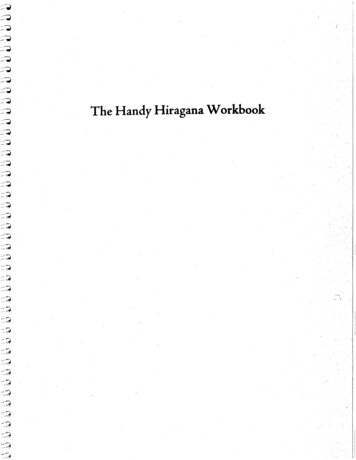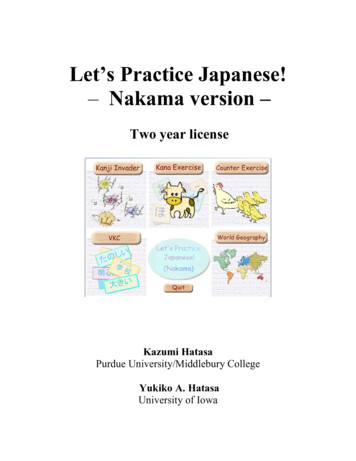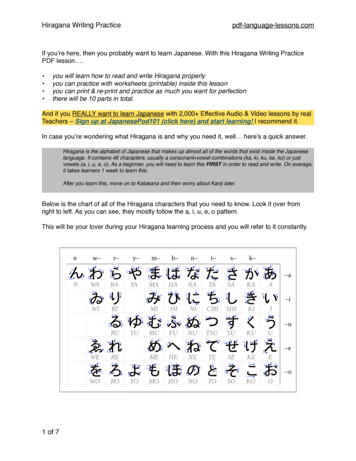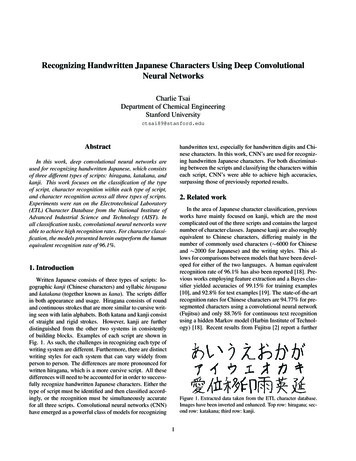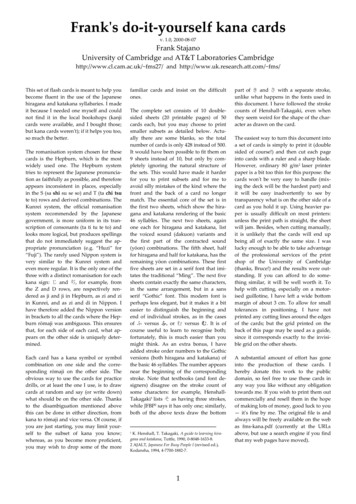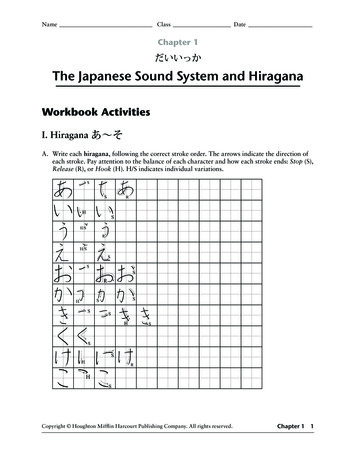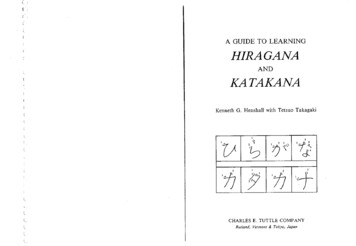
Transcription
A GUIDE TO LEARNINGHIRAGANAANDK A TAKANAKenneth G. Henshall with Tetsuo TakagakiCHARLES E. TUTTLE COMPANYRutland, Vermont & Tokyo, Japan
A GUIDE TO LEARNINGHIRAGANAANDK A TAKANAKenneth G. Henshall with Tetsuo TakagakiCHARLES E. TUTTLE COMPANYRutland, Vermont & Tokyo, Japan
PART rn: FINAL REVIEWAbout JapanFood Items QuizFlora and Fauna QuizPersonal Names QuizKana Word SearchQuiz AnswersDo-It-Yourself Kana ChartsThe Iroha VerseH O W T O U S E T H I S BOOKThe main aim of this book is to help students achieve competence in reading and writingkana, the phonetic symbols that are fundamental to written Japanese. The book starts witha section entitled An Explanation of Kana, which contains everything the student will needto know about the two kana systems of hiraganu and kotakuna. Part I of the workbook section then systematically introduces each hiragana symbol, voiced form, and combination,and provides ample practice and review. Pan I1 does the same for katakana, while Part IIIprovides an overall review.The Explanation of Kana outlines the function and origin of kana, the difference betweenthe two kana systems, the various sounds, the combinations, and the conventions of usage.It attempts to be detailed and thorough so that it can be used for reference at any stage.Though all the information about kana is grouped together in this one section for ease ofreference, it is not expected that the student will read it all before starting on the practicepages. In fact, to do so might give the impression that kana are perhaps rather formidable,which is not really the case at all. (Just ask any Japanese child!) We recommend that thestudent start work on the hiragana practice pages after reading the first three subsections on the function, origin, and basic sounds of kana. After finishing practice of the forty-sixbasic hiragana symbols the student should go back to the Explanation and read the subsection on additional sounds, then work through the rest of the hiragana practice pages beforemoving on to the karakuna practice. The final subsection, on other points to note, is mostlyconcerned with special karakana combinations and can be left until the appropriate point inthe kamkana practice pages, just prior to the final review. Students may modify this order,but we recommend finishing practice of one kana system before moving on to the next.In the practice pages of Parts I and I1 each kana symbol is allotted half a page, penittingplenty of writing practice in the boxes given. We suggest working in pencil, rather thanink, as this will allow for erasing and repeated use. Stroke order and a pronunciation guideare also given for each symbol. In addition, for each symbol there is an illustration of itsgraphic evolution from its "parent" character (see Explanation of Kana) and a referencenumber for that character as it occurs in A Guide to Remembering Japanese Characrers(Charles E. Tuttle Company, 1988), together with the character's pronunciadon. This maybe of interest to readers wishing to continue their studies of written Japanese to an advancedlevel. (However, some of the original characters are no longer commonly used and therefore are not included in A Guide to Remembering Japanese Characters.)
After approximately every ten symbols there are "mini review" pages for further practice,this time using whole words. These are cumulative, containing symbols not only from thegroup just completed but from earlier groups. The mini reviews can be used purely forcopying practice, or, by covering the cue kana on the left side of the page, as more challenging writing exercises. They can also be used as vocabulary exercises.Part 111, the Final Review, contains exercises, quizzes, and "do-it-yourself' charts. Unlikethe reviews in the first two parts it combines the two kana systems, as is natural in Japanesetexts. And for a more natural effect the boxes used earlier in the book to help achieve evenspacing and proper smoke lengths are dispensed with in this final part.The words appearing in the reviews have k e n carefully chosen in keeping with an additional aim of this bmk, which is to expose readers to key words related to Japanese societyand culture. The prime criterion for selecting review words was their suitability for practicing the h n a symbols, but we thought it would be helpful to students if in addition thesewords could, whenever possible, have panicular relevance to Japanese culture. About halfof the 450 or so vocabulary items in the book fall into this category. It is beyond the scopeof the book to explain these in detail, but students who take the trouble to find out moreabout them will be rewarded with a broadened appreciation of Japan's society and culture.In short, we intend that these words should be used as a sort of checklist for an explorationof Japan, rather than simply memorized as isolated vocabulary items.Readers will occasionally encounter a semicolon between English equivalents given for aJapanese review word. This indicates that the Japanese word is a homophone, that is, aword having a different meaning but the same sound as another. Normally these homophones would be written with different characters, but when expressed in phonetic kanascript or romanization such differentiation is not possible. The English words separated bya semicolon thus refer to different Japanese words sharing the same kana form. (Commasbetween English words simply indicate nuances of the same word.) It should also be notedthat there is sometimes a subtle difference in intonation between "homophones," which cannot be determined from the kana or romanintion.Finally, readers are advised to seek specialist or native-speaker guidance on intonation andpronunciation. It should be appreciated that the pronunciation guides given in this book canonly ever be approximate, owing to the variety in pronunciation of the same English wordin different parts of the world. Also, some Japanese sounds cannot be precisely representedby English letters. The Japanese "r," for example, actually falls between the English "r"and "d"But remember that, with both speaking and writing, practice makes perfect!A N EXPLANATION OF K A N AThe Function of KanaKana are purely phonetic symbols. Tnat is, they are written representations of pronunciation. They can express the entire Japanese language in writing, though in practice the written language uses a mixture of kana and kanji (characters taken from Chinese).There are two kana systems: karakana and hiraganu. Kczakizna is now mainly used forwords taken from languages other than Chinese. Hircgam is the more important of the twosystems, and is used for everything not written in h a h m or kanji. Kanji show meaningsof words, though they also have pronunciations. Normdly they are used for nouns and thethe unchanging part (the stem) of verbs, adjectives, and adverbs, while hiragana symbolsare used for the changing pans (not3bly endings). For example, the verb iku means "go,"while ikanai means "not go." The stem is i-, and this is usually written with s kanji, whilethe variable endings -ku and -kanai are untten in hiraganu. Hiragana is also used to writeparticles, and other words where kanji are not appropriate. To all intents and purposes thetwo kana systems are not interchangeable, and are rarely mixed within a given word. Therule is: katakana for non-Chinese loan words, hiragana and kanji for the rest.The student of Japanese should ideally aim to leun all the two thousand kanji in commonuse. They play a very practical role in graphically and distinctively conveying the meaningof a written statement, unlike a purely phonetic script, and thereby aid rapid understanding.And naturally, no one can expect to rsad unedited Japanese texts without a knowledge ofkanji. However, learning the kanji is a time-consuming task. Many of them are structurallycomplex, and many have a wide range of meanings and pronunciations.Kana, on the other hand, are much fewer in number, with only forty-six basic symbols ineach of the two systems. They are simple to write, and, with very few exceptions, theyhave fixed pronunciations. If you don't know the kanji for a particular word, but know thepronunciation, you can just express that entire word in kana (hiragana, that is; rememberthat katakana is for non-Chinese foreign words). In other words, while not ideal, kana(hiragana) can substitute for kanji. This means that even beginners can expressthemselves in functional written Japanese with relatively little effort.
The Origin of K a n aeaning "borrowed name," for the kana symbols areThe word kana derives from karinsimplified forms of certain borrowed Chinese characters used for their sound (though, confusingly, the same characters lent their meaning in other contexts). The prefix hira- means"ordinary," with connotations of "informal" and "easy," and in this particular case"cursive." Thus hiragana means "ordinary (cursive) kana," and indeed hiragana has traditionally been the more commonly used of the two systems, and the more cursive. The hiragana symbols are simplifications of whole Chinese characters. For example, the kana &(pronounced like the "a" in "car") derives from a cursive rendition of the character (pronounced "an"). Kata- means "one side" or "partial," pointing to the fact that karakanasymbols derive from one part of a Chinese character. For example, /I (pronounced like"ee" in "meet") is the left-hand part of the character /1? (also pronounced "ee").awkward, but that is really a problem relating to the Japanization of non-Japanese words,rather than to the kana system itself.Each of the two kana systems contains the same basic forty-six syllables, arranged in thesame order. The basic syllabaries are as follows (combined for convenience, with the katakana written slight1y smaller).VOWELSBoth systems evolved around the end of the eighth century. In those early days hiraganawas used mostly by women, while men preferred to use the more angular karakana. However, these associations have long since disappeared.The Basic Sounds Represented by K a n aKana symbols basically represent syllables, and the kana systems are therefore syllabariesrather than alphabets. Generally the syllables are crisp and clear combinations of one consonant and one following vowel, or one vowel by itself. There is only one consonant thatexists as a syllable and kana symbol in its own right, n.The use of English letters to refer to Japanese sounds and symbols can produce a numberof apparent irregularities. Among other things a combination of consonant and vowel inJapanese will not necessarily have the same pronunciation as in English. For example,while , \ is found in the h group (see the table that follows), its pronunciation is actuallycloser to the English sound "fun than "hu." To facilitate pronunciation the romanizationused in this book is a version of the Hepbum system, which transcribes -3 \ as fu ratherthan h,but readers should appreciate that there is no direct equivalent in Japanese to anEnglish "f." Similar cases of convenient but seemingly irregular romanization are found inthe s group and r group. This may begin to seem complicated, but in fact correspondencein Japanese between kana spelling and pronunciation is much simpler than in the case ofEnglish and its alphabet. Attempts to express certain loan words in karakam can seemThis order is known as the gojbnjun, meaning "the fifty sounds order." In fact, there arenow only forty-six basic symbols (sounds) officially in use. Yi, ye, and wu do not exist.Wi (and we (/ f ) were officially removed from the list in 1946 since thesounds were considered sufficiently close to i and e to be represented by the symbols forthese. However, the symbols for wi and we are still encountered on rare occasions.A/ )2The gojrionjun is the standard order followed by dictionaries and other reference works. It
VOWELSis therefore particularly important to remember it. To this end, the following mnemonic,which is a modified version of one taught by Professors Dunn and O'Neill of the university of London, may be helpful.r1IIAh, kana signs! Take note how many you read well (n).The reader will have taken note of the fact that the first letters of these words follow thegojConjun coilsonant headings. With apologies to mathematicians, even the syllable n (XI)is represented, by the mathematical symbol "n" indicating the utmost number (in this case92, the scm of the two kana systems).The syiidde n ( A )is sometimes called the "independent n" but in fact it can never be usedtruly independently. Nor can it ever start a word. When working from romanization it issometimes difficult to tell whether a non-initial n followed by a vowel is a syllable from then- group, or whether it is n ( A ) followed by an independent vowel. For example, ranicould be eitherlC(val1ey) or f i A b \(unit). Context usually makes this clear. To avoidambiguity some romanization systems use an apostrophe after the n that represents A.Thus ,(, l can be romanized as tan'i. Note also that in romanization & is sometimeswritten as rn before a p, b, or m, as in shimbun for shinbun (newspaper). This practice isby no m a n s universally followed (and is not followed in this book), but its existence doesindicate one of the exceptional cases where the pronunciation of a kana symbol could besaid to vary slightly according to contextq:(6)except when they clearly derive from chiand fsu (7)andJi and zu are writtenin compounds or repeated symbols. For example, hanaji (nosebleed, from h a m [nose] andchi [blood]) is 1% @j': and rsuzuku (continue, from r s u r s h ) is 73- .A combination of a consonant and y- is known as a yoon, meaning "conuacted sound."Any of the seven basic consonants k, s, t, n, h, m, or r, or voiced or half-voiced consonants, can be used. The symbol that represents these consonants plus i, for example(ki) or 1(shi), is followed by a symbol from the y- group - either j a , yu, or yo as appropriate. This second symbol is written smaller, whi!e tke i sound is barely pronounced and isdropped in romanization. Thus kyo is expressed asand shu (syu in some romanization systems) as S .P If the .& orof our examples were written the same size as thepreceding symbols, then they would be treated as uncombined symbols and read kiyo orshiyu respectively. Full tables are given below. (See also pp. 59-62.) 3kAdditional Sounds Represented by KanaIn addition to the forty-six basic symbols, there are sixty-one classified modifications andcombinations in each system, and a few further special combinations as well. This maysound alarming, but in fact it involves only a handful of new points to learn.The first is the dakuon, meaning "voiced sound" or "hardened sound." Sounds startingwith the unvoiced consonants k, s, t, and h are voiced as g, zlj, dlzlj, and b respectively ifthe diacritical marks ti are added to the upper right side of the basic kana symbol, asshown in the following table. (See also pp. 52-56.) The table also shows handakuon,meaning "half-voiced sound," which applies only to sounds starting with h. The additionof a small circle o to the upper right side of the appropriate basic kana symbol changes thepronunciation from h t o p (as opposed to changing it to b in the case of the full dakuon ).---Note thatcombinations rarely occur.
Some consonants - essentially k, s, t, a n d p -can be doubled by inserting a small tsu (7or v )in fiont of them. This combination is known as a sokuon (double consonant). Thusg& (school term) is expressed as 8% 5. The little T or v is not pronounced as such,but the consonant that follows it is given, as it were, a double amount of time for its pronunciation. It is important to apply this extra time to the consonant only, and not to the following vowel. Thus the word in our example should be pronounced gakki and not gakkii.These double consonants can never begin a word. (S& also pp. 57-58.)Students commonly make the mistake of trying to write a double n, as in words like annai(guide), with a small 9 .The correct way is to use X / to represent the fust n. Thus annaishould be written ,,/ k L!&,The lengthening of vowels (including the vowel sound of syllables in which a consonantprecedes the vowel) can also cause errors, especially in the case of the long o. In romanization long vowels are usually indicated (if at all) either by writing the vowel twice or by amacron, as in uu or zi for a long u. For loan words in karakana, a barlike symbol(or )with vemcal script ) is used. Thus rabZ(rubber) is written ? t i - . In hiragana, the vowels a, i, u, and e are doubled by simply writing , 1 1 , j ,orrespectively after the pre5 A. (The doubling of a and eceding symbol. Thus okiisan (mother) is written hactually occurs infrequently in hiragana. What sounds like a long e is usually e followed byi, as in -kkL Lsensei) , [teacher].) A long o can sometimes be formed by doubling in thesame way as with other vowels, that is, by adding h',but it is more commonly formed byadding j (u). Thus s6 (so, thus) is written ?!j. The long o that takes & was once pronounced slightly differently from the long o that takesbut that is no longer true, and itis necessary to learn each word with a long o sound case by case. Fortunately, there areonly a few common words that require the addition of &' as opposed to j. These include6kii (big, ,- ,-2L I), oi (many, &;h.L I), r6i (far, 2 L 1 ), t8 (ten, k &'), and t6ri (way,road, k f i [ J). Students should take particular care not to be misled by the common romanization practice of writing a long o as oo, when in hiragana it is usually & ( 0 )plus (u).- ,3Caution is also needed when transcribing from kana to romanization. Always check that anapparent long vowel really is a long vowel, and not two unlinked vowels. A typical case ofthe latter is a verb whose variable ending starts with the same vowel as the last vowel of thestem, or appears to combine with it to make a long o. For example, the verb j,meaning"go with," should always be romanized as sou and not s6 or soo. (By contrast, l/i jmeaning "thus," being a genuine long vowel, is romanized as so or soo.) Similarly, suu is theromanization for the verb j (suck), rather than szi, and kiite is the way to romanize thesuspensive 3 1 1 7 (listening), rather than kze.Other Points to NoteThere are three common cases where kana usage is distinctly irregular. They all involveparticles, namely the topic particle wa, the object particle o, and the directional particle e,,and A respectively, and not ;h,&,(meaning "to"). These words are writtenandas might be expected. The irregularities result from the failure of writing conventions to keep pace with pronunciation changes over the last century or so.kCertain further usages need to be noted with regard to katakana loan words only. These arerelatively recent attempts to express non-Japanese words with greater accuracy, and tend toetc.) seen earlier. That is, they combine twobe an extension of the yoon principlekana symbols, the fust one lending only its consonant sound and this fact being indicatedby the small size of the second symbol. For example, "f' sounds can be approximated byfollowing fu (7) with a small vowel. Thus fa,fl, fe, and fo are written as 77-,2 ,and 7' respectively. Similarly, "q" can be represented by kuplus a small vowel, as inT (quarter).A German-style "z" (as in "Mozart") can be shown by rsu (HAplus a smallvowel, i . e . , % - \ ) & o z a r t ) ."She" (as in "shepherd"), "chew(as in "check"), and thevoiced version "je" are written as yz. - andThough not a consonant, u (13) isused in a similar type of combination, to produce "w" sounds. As mentioned earlier, thesounds wi and we are still occasionally found expressed byandrespectively, butnowadays are usually written asand 19,. Thus "whisky" (uis&) is usually writtencould be used for wo, but this has become so associatedasX - . Theoreticallywith the object particle o thatis used instead. (Wa, however, is represented by '7 .)In similar fashion, i ) can be followed by a small I:to express "ye." Thus "Yemen" isRemarkably, an extension of the use ofhas'seen diacritical marks added to itin order to express "v." Thus "Venus" is j - f)!,. The English sounds "ty" or "ti" (asin "part).") and their voiced equivalents "dy" and "di," which were once expressed ratherunfaithfully byand )"respectively, are now written as ? and. Thus "party"is I\'5 -. The "tu" of "tuba" and the "du" of "due " can be expressed by 1and 7 2 ,giving 5-,\"(tuba) and duet), while the "Tou" of "Toulouse" can be shownby b, (a voiced version is also possible).7 ,(3)9s.(4dL-)(;.413 31 9 134f;These combinations have very recently received official approval, panicularly when used inproper nouns such as place names and personal names. However, there is also official recognition of established usage, such as of b for v. This means that in practice some wordscan be written in a number of ways. "Violin" can be e i t h e r j ; I) y or] ('4 l) Ij forexample. In cases where a certain usage has become particularly firmly entrenched in theJapanese language the old rendition is favored, such as 5IL3Ji(mirukusEki) for2e-
"milkshake" (but note that "Shakespeare" is /r--?A EOr).At the same time, it is alsopossible to make up new combinations as appropriate, such as 5.(ni) plus a small z (e)to express the nye sound of the Russian nyet. In short, the student should be prepared fora range of creative and sometimes inconsistent usages.Katakam is very occasionally used for words other than loan words. For example, i t canbe used to emphasize or highlight words, such as entries in academic reference works, andis also used in telegrams and certain military and official documents. In such cases, whenused for purely Japanese or Chinese-derived words, its conventions of usage are identicalto those of hiragana. Long vowels, for instance, are formed by adding the appropriate(school) is :, 3 t ? , rather than ': 7 -.vowel and not by a bar. Thus g*A U Msymbol can be repeated by the special symbol 4 . This can also be used when thesecond symbol is a voiced version of the fust, in which case it becomes 1". Where morethan one syllable is repeated, in vertical script only.(or {" if the fust of the repeatedIsounds is voiced) can be used, with the symbol covering two spaces. These repetition symbols u e known collectively as odoriji (jump symbols). Students need to recognize them,but should only use them, if at all, with caution. They are not compulsory, and have a number of resmctions on their usage. For example, they cannot be used where the first symbolof one word is the same as the last symbol of the word that precedes it (as in kuroi ishimeaning "black stone"), or similarly in compound words where the first symbol of the second word coincides with the last symbol of the fust word (as in tama-matsuri meaning"festival of the dead"), or where the-first symbol of a variable word ending is the same asthe last symbol of the word stem (as in Ri-kimasu meaning "listen"). Some examples ofc o r n usage:(mirni(ear ally, students should learn the basic Japanese punctuation marks, known as kur8ten.Full stops are written o (rnaru), and commas are written \ (ten). Quotation marks (kagi),-lare written Iin horizontal script andin vertical scriptL
HIRAGANAORIGIN(AN 223)STROKE ORDERas "a" in "car," butshorterPRACTICEORIGIN(I 419)STROKE ORDERas "ee" in "meet,"PRACTICEPEEL-
HIRAGANAHIRAGANAORIGIN(u 811)STROKE ORDERSTROKE ORDERas "u" in "hula," bulshorter-Ias "0" in "or," butshorterPRACTICEPRACTICESTROKE ORDERSTROKE ORDERas "caw in "car," butshorterPRACTICEPRACTICE
ORIGIN(KIS T R O E ORDER1129)ORIGIN(KEI105)STROKE ORDERas "ki" in "keep,"but shorteras "ke" in "keg"PRACTICEORIGINSTROKE ORDERIPRACTICE(KO 855)STROKE ORDERas "cowin "core,"but shorter3s "Ku" in "Kuwait,'mt shorterPRACTICEPRACTICE
ailovekoevoiceueabove, topkakuwriteokahillokew&rikikuhear, ask; chrysanthemumkaoface, honorkokemossiehouse, extended tII1IIIIIIIII1IIIIIIII
HIRAGANAHIRAGANAORIGIN(SA 22)STROKE ORDERSTROKE ORDERis "sawin "sarcasm,"as "Su" in "Susan,"but shorter)ut shorterPRACTICEORIGINPRACTICE(SHI, part of 1335)ORIGIN(SE 327)STROKE ORDERSTROKE ORDERPRACTICEPRACTICEshias "she" in "sheep,"but shorter. .--*. .! .I.I.I
HIRAGANAHIRAGANAORIGIN (SO,part of ZO 741)ORIGINSTROKE ORDERSTROKE ORDER(CHI 169)chi1s "chee" in "cheek,')ut shorteras "so" in "sore,"but shorterPRACTICEPRACTICEORIGINSTROKE ORDER(SU 304)STROKE ORDERtsuas "tawin "tar," butshorteris "tsu" in "tsunami'PRACTICEPRACTICE
HIRAGANA"T ,ORIGIN1(TEN 58)sushisushitsuchisoilSTROKE ORDERIPRACTICEsake'; salmonsakeIIIIIIIIIIIIIIIIItetsuiron, steelsekiseat; coughtatsustand, leave; dragontochilandutasong, poemkotothing; Japanese harpsusohemSTROKE ORDERas "to" in "tore,"but shorterPRACTICE
tasea b mtekienemyORIGIN(NA)STROKE OKDERshichi/IL4sevens "na" m "narcotic,'lut shorterasesweatsasuthrust; indicatePRACTICEORIGINlaketsuseasonarhhtomorrow(NI 906)STROKE ORDERsatoiclever, sharp (of senses)ktL) I II1IIIII1IIIIIIIIIIsekiteirock garden (Jauanese stvle)chikatetsusubwayIIIIIIIIII11I1i s "nea" in "neat,"3utPRACTICEshorter
HIRAGANAHIRAGANASTROKE ORDERas "noo" in "noon,"but shorterISTROKE ORDERas "no" in "north,"but shorter-PRACTICEPRACTICEORIGIN(HA 367)31JlSTROKE ORDER2 &STROKE ORDERas "ha" in "harm,"but shorteras "newin "net"PRACTICEPRACTICE
HIRAGANAORIGIN/ / (HI 771)STROKE ORDERORIGIN384STROKE ORDERas "hea" in "heat,"but shorteras "he" in "hen"PRACTICEPRACTICEORIGIN(FU 572)4STROKE ORDER3ORIGIN(HO 787)I STROKE ORDER.LV"howin "horn,"but shorteras "foo" in "fool,"but with softer "f'3sIPRACTICEPRACTICE
MINI REVIEW- 1% / NA - ebone wer. blossom; nosekafanacurved swordfuneboatnetsukecarved figurinekanicrabtanrrkiraccoon doghimdoll, fledglmghashichopsticks; bridge; edgeinoshishiwild boarkinusilkhekotsusoldier
ORIGINSTROKE ORDERma781)STROKE ORDERRJas "ms" in "mark,"but shorterJPRACTICElbut shorterPRACTICEORIGIN(BI 376)STROKE ORDERORIGIN(ME 35)STROKE ORDERIS "mea" in "meat,")ut shorteras "me" in "met"PRACTICEPRACTICEI
HIRAGANAORIGIN( 210)6ORIGINSTROKE ORDER(XJ399)STROKE ORDER--as "mowin "more,"but shorteras "you" in "youth,'but shorterPRACTICEPRACTICEORIGINORIGIN(YA. part of CHI 167)STROKE ORDERas "yawin "yard,"but shorterPRACTICE(YO1873)STROKE ORDERIas "Yo" in "York,"but shorterPRACTICE
HIRAGANAHIRAGANArcmuZIdmommountain, hillkimono, clothingsashimiIIIIIsliced raw d name for Japanyukatacotton kinlonomiyashrinekomeuncooked riceemakipicture scrolltsuyudewhanamiblossom viewingmikoshiportable shrinemafsupine; waitukiyoewoodblock printmJapanese plumsetomnoporcelainmum?chest, breastsukiyakisukiyakiII
ORIGIN(WY STROKE ORDERORIGIN598)I(RU 805)STROKE ORDERas "ru" in "rule,"but shorteras "rawin "mirage,"but shorterIPRACTICEORIGIN(RI 596)PRACTICEORIGIN(REI 413)STROKE ORDERSTROKE ORDERPRACTICEPRACTICEbut shorter
HIRAGANAHIRAGANASTROKE ORDERas "rowin "roar,"but shorterSTROKE ORDEREIImas "owin "or," butshorterPRACTICEORIGINPRACTICE(WA 416)ORIGINW)1-1STROKE ORDERSTROKE ORDERPRACTICEPRACTICE7as "wa" in "watt"I
HIRAGANAwanbowl; bayuchiwaround ; to fishhotmufireflykorethism nfutonfur0bathrekishihistorynoriedible seaweed; pastewafukuJapanese clothinghmuspring; to stretchrironvli;lhlIre ipoliteness; soul; shikiIcloth wrapper for parcelsIIIIIlIlIcastle; whiteharmNihonJapanHinomaru Rising Sun Flagsakuracherry blossomsamumrnharakirisamuraiI1IIIIIIllIIlIlIII1
HIRAGANAHIRAGANAVOICED AND HALF-VOICED SOUNDSdaas "da" in "dark" but shortergi as "gee" in "geese" but shorterjias "jee" in "jeep" but shorterguas "goo" in "goose" but shorterzu as "zoo" but shortergeas "ge" in "get"de as "dewin "desk"goas "go" in "gore" but shorterdoas "doo" in "door" but shoncrzuas "za" in "bizarre" but shorterbaas "ba" in "bark" but shorterjias "jee" in "jeep" but shorterbias " h a " in "beak" but shorter pias "pea" in "peak" but shorterzuas "zoo" but shorterbuas "boo" in "boot" but shorter puas "poo" in "pool" but shorterzeas "ze" in "zest"be as "be"in "beg"zoas "zo" in "Azores" but shorterbogaas "ga" in "garden" but shorterpapeas "bowin "bore" but shorter poas "pa" in "park" but shorterasin "ppg"as "po" in "pork" but shorter
HIRAGANAREVIEW OF VOICED AND HALF-VOICED SOUNDSIobiwaist sash for kimonoImikadowriting brushIIyl ' yJ1Iold word for Isobabuckwheat noodles; sidemikujiwritten oracleIbiwalute; loquat bgangsterI@awooden clogsnigiririce ballIObonBuddhist festivaltengulong-nosed goblinIKabukiKabuki dramahanajinosebleedIojigibow (head)mizuwan'whisky and waterIWPowalk, strollw njiruknow, believeImonpeold-style work pantsdaibutsularge statue of Buddha
HIRAGANAREVIEW O F DOUBLE VOWELS AND aiseniorZ (ee)yesbonsaibonsaikiisky, void, asumo grand championti3tower, pagodatenpuratempuratouasksenbeirice crackerkappamythical creaturehanafudaflower cards (game)shikkilacquenvareFujisanMt. Fujisum5sumolike th2t; Oh!
HIRAGANAHIRAGANACOMBINED SOUNDS KYA -RYOwrisandalssDjinumeraly iigentranquil beautygak&schoolshochak5yOred leaves6kiibigk e dkendohya ' j:zI.jlIIIjingiishrinefirinwind chimeshintaShintokikiairport15y, -11I1II11I1IIIIIIchuchohyo
HIRAGANAHIRAGANAVOICED COMBINED SOUhTDS GYA -B Y 0 I2-q - piREVIEW OF COMBINED SOUhDSkydu0%- VJ-HALF-VOICED COMBINED SOUNDS PYA -PYO 1guest, visitorshojisliding screenbyobufolding screenjinjashrinech
rule is: katakana for non-Chinese loan words, hiragana and kanji for the rest. The student of Japanese should ideally aim to leun all the two thousand kanji in common use. They play a very practical role in graphically and distinctively conveying the meaning


